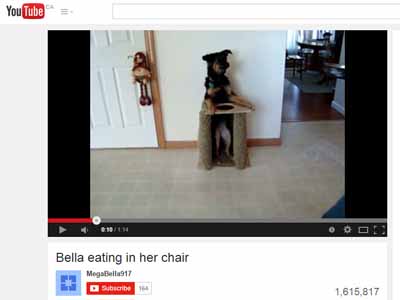
A cute dog video that has gone viral on social media shows a dog named Bella climbing into a dog sized “highchair” to eat her dinner. People often share it with lighthearted comments joking that the dog is high class, elegant or spoiled.
Since the video plays in Facebook and other social media, the story behind this adorable but seemingly over-the-top dining arrangement gets lost. If you view the video on Bella’s YouTube page, the family has shared that Bella has congenital megaesophagus.
What is megaesophagus?
Megaesophagus is a condition where the tube that carries food and water from the mouth to the stomach has lost its ability to move the food down. This can be congenital (inherited genetically), or acquired (develop later in life). Both dogs and cats can have it, but it is more common in dogs.
It’s pretty serious because it can quickly lead to malnutrition and even aspiration pneumonia if pets breathe in something they’re trying to swallow. Some signs include:
- Pets asking for food and acting hungry, but then picking at their food
- Gurgling sounds when trying to swallow
- Regurgitation of food and water
- Bad breath
- Weight loss and muscle weakness
So what’s up with the highchair?
Megaesophagus is managed by treating the underlying cause if there is one, and by finding ways to help the pet get nutrition.
The chair, known as a Bailey Chair, is designed to keep the pet upright while eating so that gravity can help the food get to the stomach. The pet will usually stay in that position for at least 10 to 15 minutes after eating to give the food time to work its way all the way down.
Other measures include:
- Feeding a high calorie food so pets can eat less and get the same energy.
- Customizing the texture of the food – some pets do best with a gruel-like consistency, while for others, small chunks, like meatballs, are just right to stimulate the esophagus to contract.
- Some pets can’t eat at all, in which case a feeding tube may be needed. It’s not as bad as it sounds – they are generally well-tolerated and bypass the difficulties of the condition completely.
If you think your dog or cat is having problems with swallowing, it’s best to get him checked out right away.